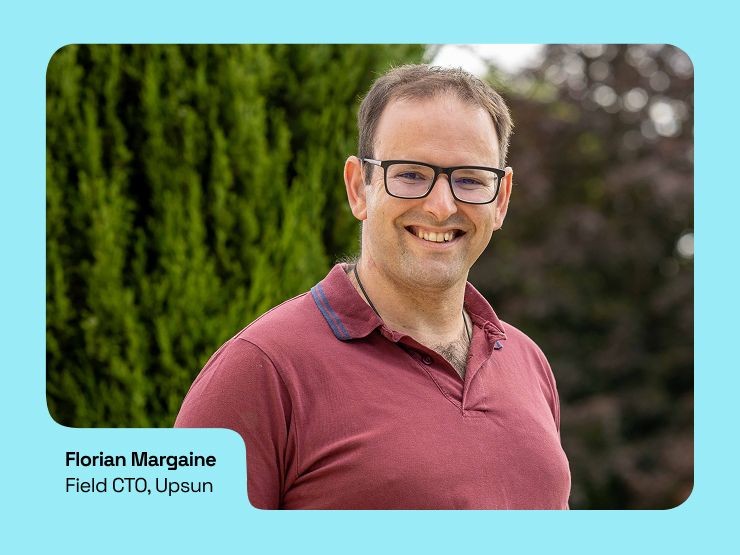- English
- français
- Deutsche
- Contact us
- Docs
- Login

Evolution of a hard-of-hearing person with technology
Beyond the horizonAccessibilityUpsunners
05 November 2025
Hello, my name is Florian, I'm 37 years old, and currently occupy the position of Field CTO at Upsun. I've been with this company for 11 years. My primary job is to help our teams collaborate better in order to solve our customers’ problems. There's an irony in my role: I have had profound hearing loss since birth.
With hearing aids, I can participate in conversations under the right circumstances. Quiet rooms work well. High-quality audio sources work well. But restaurants, street conversations, and most standard TV broadcasts remain largely inaccessible. My hearing cuts off completely above 8kHz, which means high-frequency consonants like "f" and "s" are difficult to distinguish. I've never actually heard "th" pronounced correctly. Put me in a calm room within reasonable distance, and we can solve problems together. Add background noise or distance, and communication becomes challenging.
On the surface, profound hearing loss seems incompatible with a role centered on collaboration. But technological progress over the past 15 years has changed that equation. I want to share six advancements that have transformed accessibility for people like me, along with three requests for the tech community.
Hearing aids: incremental improvements
The hearing aid industry moves slowly. It's a niche market dominated by a few large manufacturers, and their primary customer base skews older. Innovation isn't a priority. When I purchased my current pair in 2020, they lacked built-in Bluetooth—a feature that had been standard in consumer electronics for over a decade.
Despite this glacial pace, hearing aids have been foundational. They've allowed me to navigate most of my life without immediately signaling my disability. That invisible accommodation matters more than it should, but it does matter.
Subtitles transform entertainment
In the 2010s, French television began adding subtitles as a standard feature. Streaming platforms accelerated this trend, with most offering subtitles by default. This was the first time I could actually enjoy movies and TV shows. Before subtitles became widespread, I was missing half of every story.
Today, subtitles are ubiquitous. TikTok videos, YouTube Shorts, and Instagram Reels routinely embed text directly into the content. What started as an accessibility feature has become mainstream, benefiting everyone from language learners to people watching videos in quiet spaces. The normalization of subtitles has been one of the most democratizing changes in media accessibility.
Text-based communication creates equality
The rise of workplace chat platforms—HipChat, then Slack, then Discord, and all their successors—fundamentally changed professional communication. When text is the primary communication medium, everyone operates on equal footing. I'm not struggling to hear. No one is struggling with accents or speech impediments. Information flows uniformly.
Yes, text-based communication makes conveying emotion and nuance more difficult. But that tradeoff is worth it. When everyone has the same level of access to information, the quality of collaboration improves dramatically.
This leads to my first request: invest in written communication skills. Text transcends the limitations of hearing, accents, and speech patterns. It's the most accessible way to share information. When your team communicates effectively in writing, you're not only accommodating people with hearing loss—you're creating better documentation, clearer thinking, and more inclusive collaboration.
Bluetooth connectivity opens new doors
Around 2015, I acquired a Bluetooth accessory for my hearing aids. This small device connected to my laptop, phone, or TV, then streamed audio directly into my ears. The improvement was remarkable. Movies became comprehensible. Video calls went from frustrating to functional.
The change in comprehension was dramatic. On video calls, I went from catching roughly 30% of conversations to understanding 50-80%. That increase might not sound life-changing on paper, but it meant the difference between being a passive observer and an active participant. Bluetooth connectivity was the first technology that made remote work genuinely viable for me.
Live captions revolutionize video calls
At Upsun, we've used Google Suite since the beginning. I've worked remotely since I was hired in 2014. Video calls were always hit or miss. They improved in 2015 with the Bluetooth accessory, but they were still far from ideal. In early 2020, Google started rolling out live captions in Google Meet.
The impact was profound.
My understanding of conversations jumped to 90-100%. This fundamentally changed how I participated in meetings. This feature alone probably enabled me to collaborate much better with other people. Live captions then rolled out to other platforms: Microsoft Teams, Zoom, and others. Not all platforms support them though (like Slack's Huddles), so if you see me pulling you back to Google Meet, this is why.
My second request: use and encourage platforms that support live captions. Prefer ones where you don't have to ask the host to change the language settings (looking at you, Teams). The fewer barriers to usage, the more people you include. Having to ask the host to change the language every time raises unnecessary obstacles.
You'll notice that all these advancements helped me collaborate online, but none addressed in-person conversations.
Smart glasses: the final piece
The sixth advancement is what inspired me to write this article: live captions in glasses. I've watched "smart glasses" for the past 2-3 years. Something always seemed promising, but there was always an issue. One product used the phone's microphone. Another didn't support prescription lenses. Yet another looked good but cost $5,000. Until this year: Captify released their Captify Pro glasses. They support prescription lenses, have a directional microphone, and are affordable (I realize affordability is subjective). They checked all the boxes.
A few weeks ago, we organized the Evolve conference—a place to meet our partners. As Field CTO, this was where I wanted to be. I was anxious because conferences are typically noisy environments. I've never had good experiences at conferences or summits unless I walked away from the noise. The big networking room where everyone gathers has usually been my nemesis.
For the first time, I had these new glasses, and they changed everything. I could be part of conversations in the middle of the networking room. I could understand most of what was said. It was a revelation. The evening party was equally amazing. Being able to have discussions with everyone without needing to escape the music changed everything. I had a blast. This latest advancement made a huge stride in closing this gap.
The glasses do have some shortcomings. They're new, so they still have minor issues here and there. The battery lasts 2-3 hours. Thankfully they recharge in only 30 minutes, but I can't wear them all day without worrying about power. They have some small UX issues, like no warning when the battery runs out. Overall though, the UX is clean and simple, and they accomplished their mission. That's why I wanted to give this product a shout-out.
My third and final request: make conferences more accessible to hard-of-hearing and deaf people. Most conferences give microphones to speakers. It's possible to route the sound through something that displays live captions (you could even connect the mic to a Google Meet call). This completely changes the experience. The talks become immediately accessible. The glasses help, but they work better with people close by, and they have limited battery life anyway.
The time is now
Technology has come a long way. I can participate in meetings, enjoy movies, and have conversations at loud conferences. What was once impossible is now possible, and it keeps getting better.
Each advancement—from hearing aids to live captions to smart glasses—has opened new doors for me. But there's still work to do. By choosing accessible tools, writing clearly, and advocating for inclusive practices, you can help make collaboration possible for everyone.
The time to be hard-of-hearing/deaf has never been better. And with your help, it can get even better.
